18 Best Exercises for Building Muscular Strength
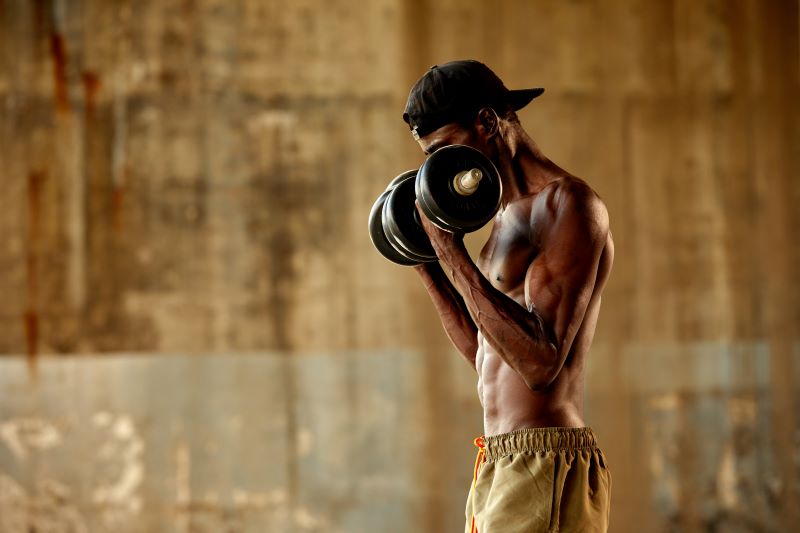
Muscular strength is a significant requirement, significantly when growing older. It is, therefore, advisable to work out to increase muscle strength. These exercises help you enhance overall physical strength irrespective of any athletic abilities.
Curious to know more about exercises for muscular strength? Find out all about it in this article.

Table of Contents

What is Muscular Strength?
Muscle strength is the capacity of a muscle or group of muscles to apply force against resistance. It is an essential component of general physical health since it makes daily tasks easier to accomplish.
Increased muscular strength lowers the chance of injury while improving posture, mobility, and stability. It also promotes metabolic and bone health, which leads to a more favourable body composition. Strength training exercises like weightlifting and bodyweight are essential for building and maintaining muscle strength.
How to Maintain Muscular Strength?
Maintaining muscular strength requires a consistent routine with various exercises and proper recovery.
- Regular Exercise: Do strength training exercises at least two to three times a week.
- Balanced Diet: Consume a diet rich in protein, vitamins, and minerals to support muscle repair and growth.
- Adequate Rest: Ensure you get sufficient sleep and rest days to allow muscles to recover and grow.
- Hydration: Drink plenty of water to keep your muscles hydrated and functioning properly.
- Consistency: Stick to a regular workout schedule to maintain everything gradually and adequately improve muscular strength.
18 Best Exercises for Muscular Strength
The following list can help you find the best exercises for Muscular Strength.
Upper Body Strength Exercises for Muscular Strength
Enhance your upper body strength with exercises targeting your arms, shoulders, chest, and back muscles. Strengthening your upper body enhances your physique, supports better posture, and reduces the risk of injuries.
1. Biceps Curl
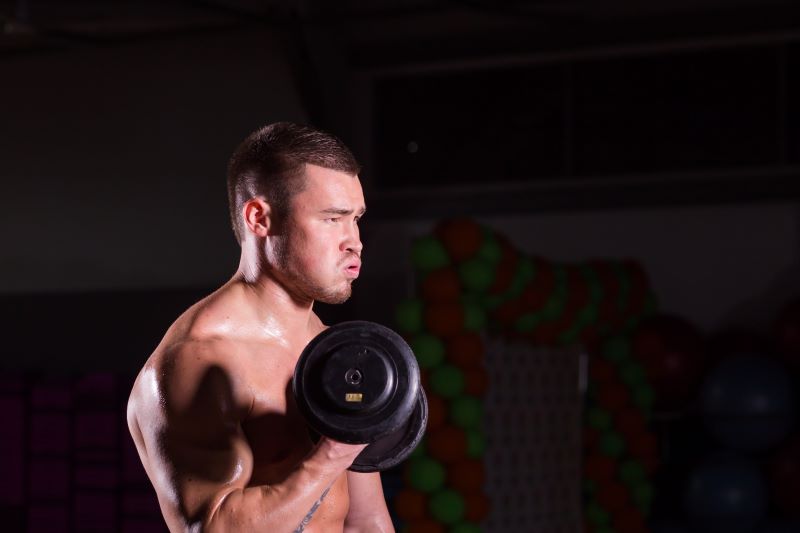
It is a popular activity for muscular strength. It helps develop the biceps to strengthen the upper arm muscles. You need dumbbells or barbells to do this.
How to Do:
- Start with standing on the floor, keeping your feet shoulder-width apart and your knees slightly bent.
- With your face looking upwards, draw your elbows towards your body while slowly lifting the weight.
- Slowly lower the hand to the original position and repeat the process in both hands.
Benefits:
This exercise is beneficial as it helps build arm muscles and boosts athletic performance. It enhances the strength of the upper arm while training the shoulders to be more stable and in control.
It is a relatively easy and practical exercise that can hardly be harmful if done correctly. However, if you have pain or injury in the rotator cuff or shoulders, you should avoid this exercise until the pain is completely cured.
2. Modified Pushup
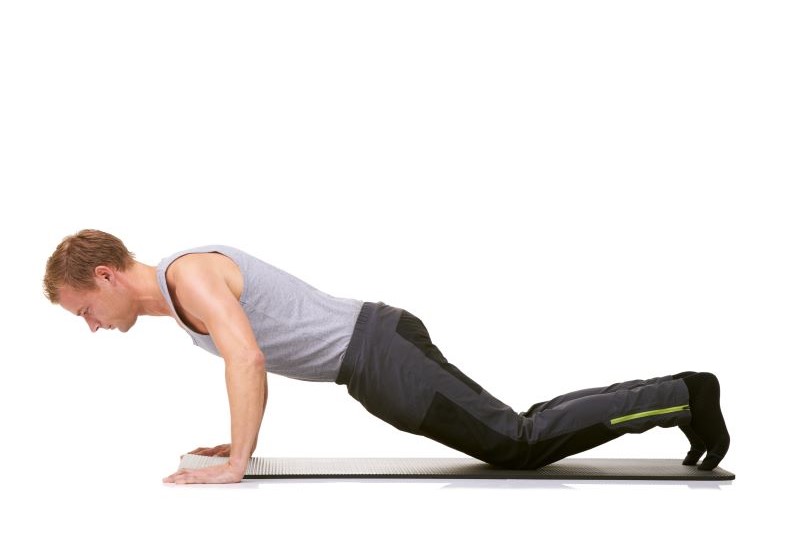
This exercise can also be effective for strengthening your arm muscles. It is beneficial for people who are unable to do full pushups. It helps to build initial strength to do full pushups in time.
How to Do:
- Start kneeling on a mat, keeping your hands below your shoulders and knees behind your hips.
- Next, tuck your toes under and tighten your abdominals. While bending the elbows, start lowering your chest towards the floor.
- Keep your neck strong. Now, press your check back up to the starting position. Keep repeating this process.
Benefits:
This exercise can have multiple benefits. It is beneficial for toning your arms, shoulders, chest, and core. Apart from toning your upper body, these pushups help you lose extra calories and gain abs. Your chest and upper back will be stronger with this exercise, and your core will be enhanced.
Pushups are simple exercises that might require extreme leg and arm strength. Therefore, individuals with pain or injuries in the legs or arms should avoid working out. Moreover, you should immediately stop this exercise if you start feeling pain in these areas.
3. Gripping
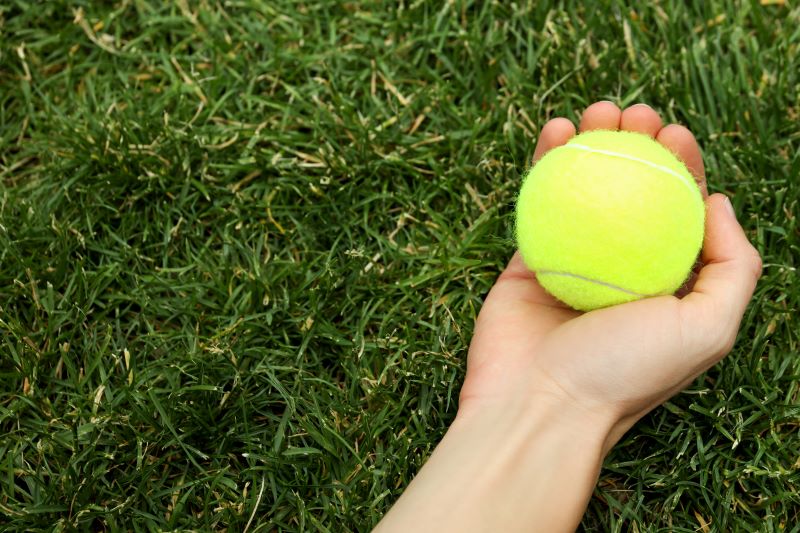
This is a simple exercise that aims at enhancing your gripping strength. It is essential to become more muscular and stay secure from accidents.
How to Do:
- Start this exercise by holding a tennis ball in your hand.
- Slowly squeeze it as hard as you can.
- Hold this position for about 10 seconds. Then, release it slowly. Keep repeating this process.
Benefits:
This exercise is beneficial for enhancing forearm muscularity, improving the look and fitness of your forearm, and enhancing your gripping strength. Your grip will be impressed with this exercise. It also improves hand endurance while improving hand dexterity.
If you are suffering from injuries in the hands and wrists, avoid this exercise as long as you do not recover. Moreover, if you feel intense pain or weakness in the hands, skip this exercise or avoid doing it for a long time.
4. Tricep Dips
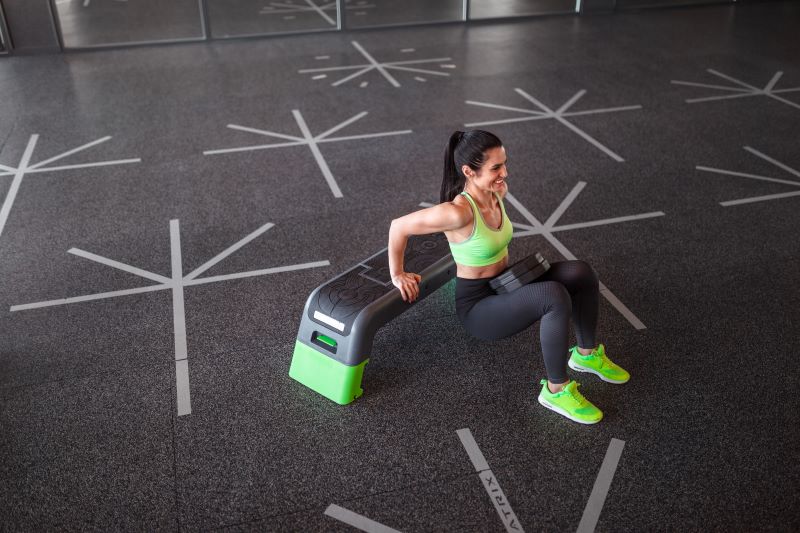
Tricep dips effectively strengthen the triceps, shoulders, and chest muscles. This exercise requires no equipment and can be performed using a stable surface like a bench or chair.
How to Do:
- Sit on the edge of a bench or chair, your hands placed shoulder-width apart, gripping the surface.
- Slide your buttocks off the edge of the bench and position your feet flat on the floor, knees bent at a 90-degree angle.
- Lower your body by bending your elbows until your upper arms are parallel to the ground, keeping your back close to the bench.
- Press down through your palms to straighten your arms, lifting your body back to the starting position. Repeat the movement for the desired number of repetitions.
Benefits:
Tricep dips effectively target the triceps, helping to tone and strengthen the back of the arms.
This exercise also engages the shoulders and chest muscles, providing a comprehensive upper-body workout. Also, tricep dips can be adjusted to suit different fitness levels by varying the dip depth or adding weights for increased resistance.
They improve functional strength, making daily activities like pushing and lifting easier. Tricep dips are a versatile exercise that can be performed anywhere with a sturdy surface, making them ideal for home workouts or outdoor training sessions.
5. Shoulder Press
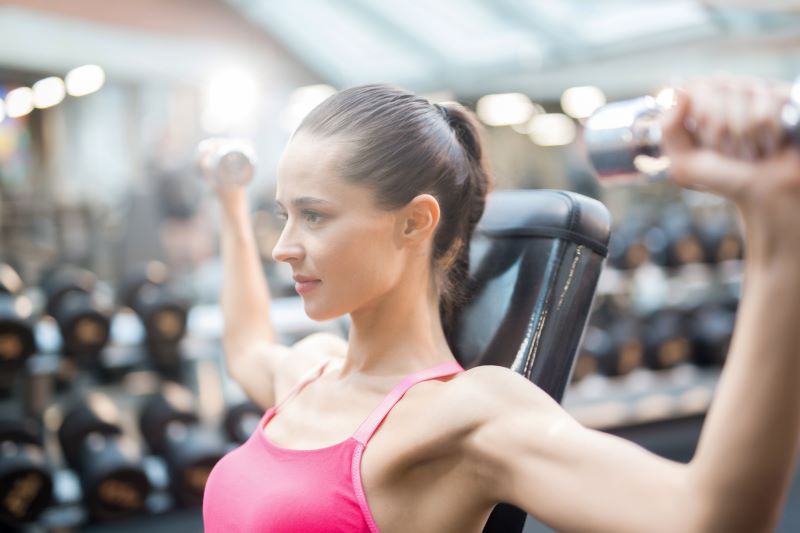
The shoulder press is a compound exercise that targets the deltoid muscles of the shoulders, as well as the triceps and upper back muscles. It can be performed using dumbbells, barbells, or resistance bands.
How to Do:
- Begin by sitting or standing with your feet shoulder-width apart, holding a dumbbell in each hand at shoulder height.
- Press the dumbbells overhead until your arms are fully extended but not locked out, keeping your core engaged and avoiding arching your back.
- Slowly lower the dumbbells back to the starting position, maintaining control throughout the movement. Repeat for the desired number of repetitions.
Benefits:
The shoulder press strengthens the deltoid muscles, helping to improve shoulder stability and mobility. It also targets the triceps and upper back muscles, contributing to upper body strength. By adjusting the weight or the range of motion, shoulder presses can be adapted to suit different fitness levels.
This exercise enhances functional strength, making performing overhead activities and lifting objects easier. Shoulder presses can be performed using various equipment, making them suitable for home workouts or gym settings.
Lower Body Strength Exercises
Focus on developing strength and power in your lower body with exercises that target the muscles in your legs, hips, and glutes. Strengthening your lower body enhances athletic performance and supports better balance, stability, and mobility in daily life.
6. Squats
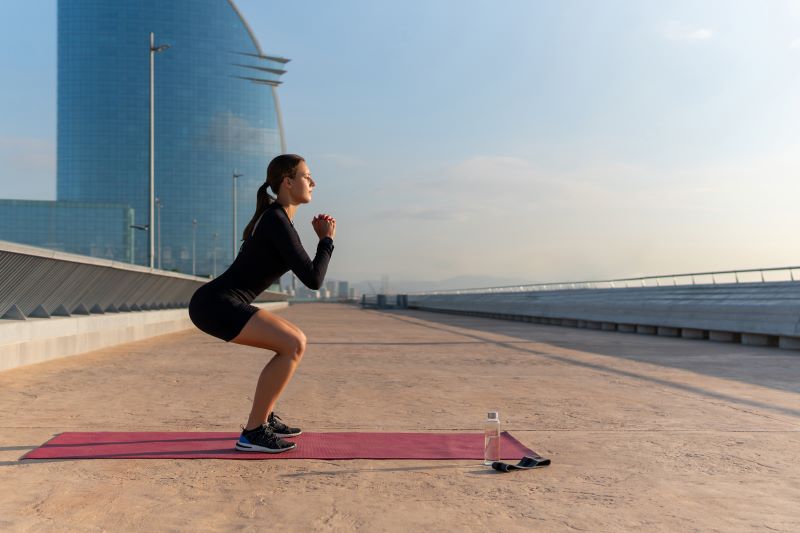
This is one of the easiest and most popular exercises for muscular strength. To perform it, you need to sit in a chair. If you plan to increase the intensity, hold a dumbbell or bar at your chest level.
How to Do:
- Stand on the floor, keeping your feet away from each other. The distance between your feet should be slightly more than the hip distance.
- Now, slowly bend the knees and squat down.
- Pause, hold this position for about 3-5 seconds, and retract to the original posture. Repeat this process at least 20 times.
Benefits:
Regular squats have multiple benefits. For instance, they strengthen your core and the muscles in the lower part of your body. They also help reduce the chances of falling and injuries in the future. Moreover, they are perfect if you plan to shed extra calories and boost overall athletic strength.
If you have knee pain and injury, limit your squatting activities. You should rather avoid this type of exercise if your condition is bad. Other than that, squatting is a safe and straightforward exercise. Try to check with your physician regarding your knee condition before starting this workout.
7. Toe Stand
It is another excellent exercise for increasing muscular strength. Toe stands originated as a balancing position from Bikram yoga. They help improve balance and core strength.
How to Do:
- Start by standing on your right leg. Keep inhaling while bringing the top of your left foot towards your right hip.
- Keep breathing while trying to establish a balance. Now, bend your right knee while anchoring the left foot on the right thigh.
- Once you reach a squatting position, lift your right heel to one side.
- Engage your core muscles and lift one or both hands off the floor. Try to hold the position while breathing.
Benefits:
This position can improve balance and core strength. It is helpful if you suffer from joint pain in the knees. This exercise also helps open your hips, strengthening your core and feet. It provides attention to neglected areas while challenging your balance.
People suffering from knee problems and intense knee pain should avoid this position. Moreover, avoiding this exercise will help those with low blood pressure, hypotension, or injury in the lower body.
8. Single-Leg Hip Raise
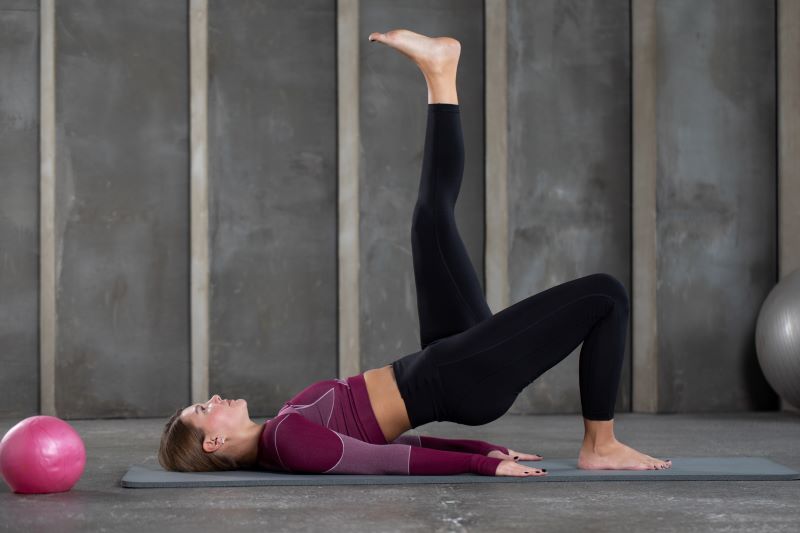
This muscular power exercise helps build strength and stability in people with glutes or hamstrings. It also improves core strength and overall coordination.
How to Do:
- Start with lying on your back with your knees bent. Keep the heels flat against the floor while keeping them hip-width apart.
- Now, take one leg off the floor and straighten it completely. Keep your stomach tight and press the remaining heel into the floor.
- Drive your hips upwards and squeeze your glutes. Now, return to the ground and repeat the process.
Benefits:
This exercise helps increase hip extension strength and the angle between the rose and thigh. It also improves sports and athletic performances and can prevent injuries. Therefore, it is suitable for people interested in sports and athletics.
Avoid this exercise if you have intense pain or injuries in the back or hips. Try not to attempt it while you are recovering. Moreover, if you have weakness in the lower body part, take proper precautions for this exercise.
Core Strength Exercises
Build a solid and stable core with exercises that target the muscles in your abdomen, lower back, and pelvis. Strengthening your core enhances athletic performance, reduces the risk of lower back pain, and improves overall functional strength for everyday activities.
9. Abdominal Crunch

Crunches are popular exercises to improve muscular strength. They can improve your muscle visibility by developing abs in the torso. Building these muscles can help improve your core muscles and overall stability.
How to Do:
- Lie on your back on the floor, keeping your knees bent. Next, place your hands behind your head and across your chest.
- Start pulling your belly button towards your spine while preparing for the movement. Slowly contract the abdominals while ringing the shoulder blades a few inches above the floor.
- Keep exhaling as you come up, and imagine holding a tennis ball under your chin. Hold at the top for a few seconds, and slowly lower back down. Repeat the process a few times.
Benefits:
This exercise is beneficial for multiple reasons. It helps to flex the rectus abdominis muscle, bringing your shoulders towards the hips. It can improve your stability. Practising this crunch can help you build a strong back and abs. It will help you stay fit and athletic for a long time.
10. Forearm Plank
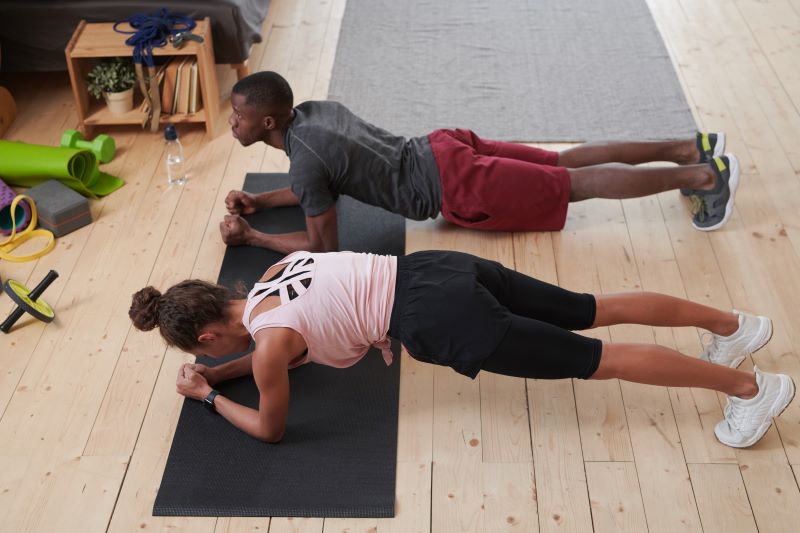
A forearm plank is an exceptional exercise for strengthening the abdominal and core muscles. People planning to build abs often keep it within their workout routine.
How to Do:
- To build a plank position, face down with your forearms and toes on the floor. Keep your elbows directly under your shoulders and your forearms facing forward.
- You should relax your head as you look down. Now, engage your abdominal muscles while drawing your navel towards the spine.
- Keep your torso straight and erect, while your heels should be over the balls of your feet. Hold this position for at least 10 seconds.
Benefits:
Strengthening the core is a significant requirement for building solid muscles. It helps you feel suitable and more physically fit. It helps to stabilise and enhance the overall balance. Engaging a range of muscles in the core building helps to boost calorie burn.
A plank position puts pressure on the elbows and wrists. Therefore, people with injuries or pain in these areas should avoid it. Notably, patients suffering from Carpal Tunnel Syndrome should not attempt this exercise. Moreover, pregnant women and little kids should also avoid this position.
11. Russian Twists
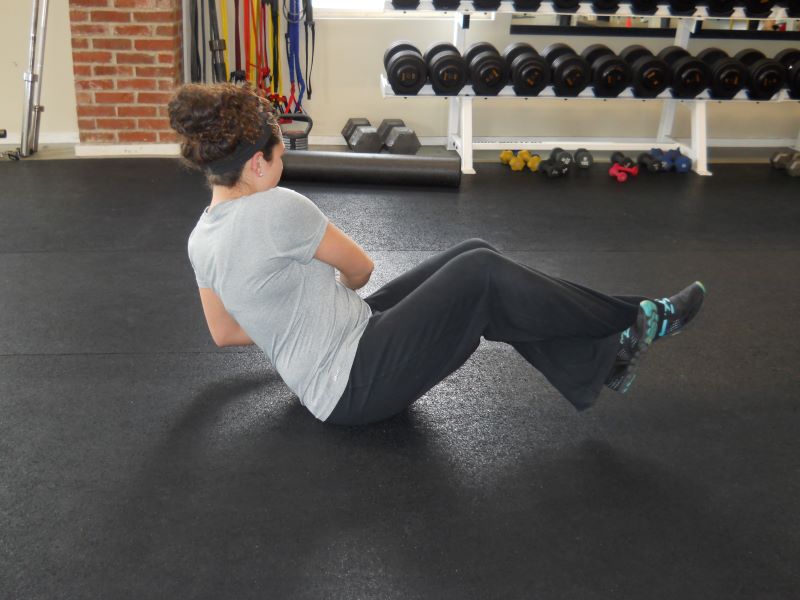
Russian Twists target your core muscles, especially the obliques, which rotate your torso and improve stability. This leads to a firmer and more defined midsection.
How to Do:
- Sit on the floor with your knees bent and feet flat on the ground. Lean back slightly, keeping your back straight and core engaged.
- Hold a weight or medicine ball with both hands and lift your feet off the ground, balancing on your glutes.
- Twist your torso to the right, bringing the weight or ball beside your right hip.
- Then, twist your torso to the left, bringing the weight or ball beside your left hip. Continue alternating sides for the desired number of repetitions.
Benefits:
Russian twists target the obliques, helping to improve core stability and definition. This exercise also engages the rectus abdominis and transverse abdominis, providing a comprehensive core workout. Russian twists can be performed with or without weights, making them suitable for all fitness levels.
They improve rotational strength, which is essential for sports and daily activities. Russian twists can be done virtually anywhere, making them convenient for home workouts or outdoor training sessions.
12. Bicycle Crunches
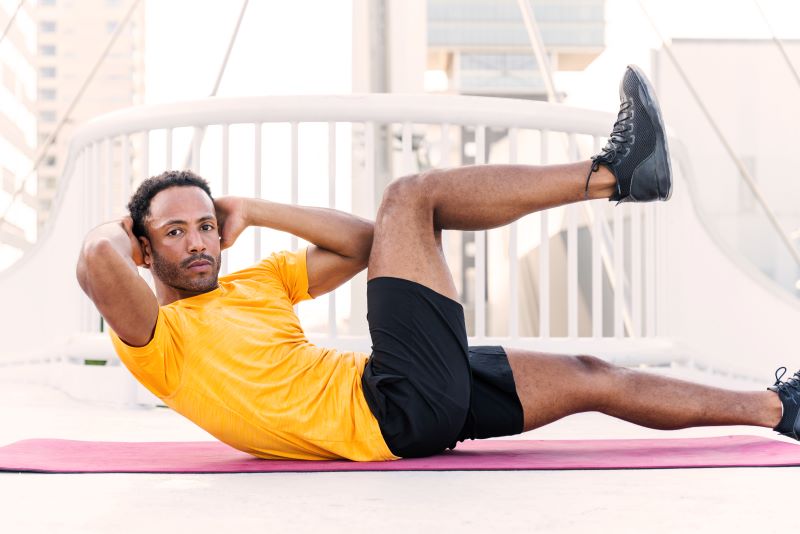
Bicycle crunches target your abs, especially the obliques on your sides, which help you rotate your torso and stabilise your spine.
How to Do:
- Lie on your back with your knees bent and feet flat on the floor. Place your hands behind your head, elbows pointing out to the sides.
- Lift your shoulder blades off the ground, engaging your core. Bring your right knee towards your chest while twisting your torso to bring your left elbow towards your right knee.
- Straighten your right leg as you bring your left knee towards your chest. Twist your torso to bring your right elbow towards your left knee. Continue alternating sides in a pedalling motion for the desired number of repetitions.
Benefits:
Bicycle crunches effectively target the rectus abdominis and obliques, helping to sculpt and define the abdominal muscles. This exercise also engages the hip flexors and lower back muscles, providing a comprehensive core workout.
Bicycle crunches improve core stability and coordination, enhancing overall athletic performance. They can be performed without equipment, making them accessible for all fitness levels. For a high-intensity challenge, they can also be included in circuit training or HIIT workouts.
13. Mountain Climbers
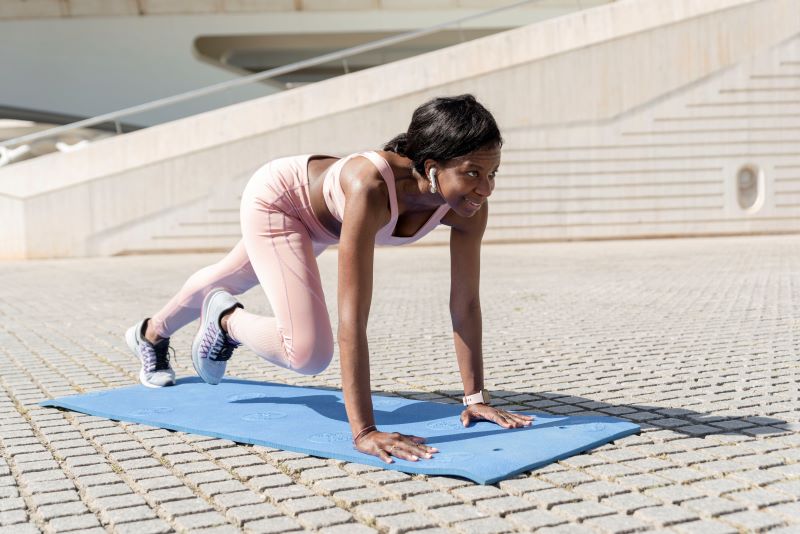
Mountain climbing is a full-body exercise that works for multiple muscle groups at once, including your core, legs, and arms, all while strengthening them through alternating explosive movements.
How to Do:
- Start in a plank position with your hands directly under your shoulders and your body in a straight line from head to heels.
- Engage your core and lift your right foot off the ground, bringing your right knee towards your chest.
- Quickly switch legs, bringing your left knee towards your chest while extending your right leg back. Continue alternating legs in a running motion for the desired number of repetitions.
Benefits:
Mountain climbers improve cardiovascular fitness and endurance, making them an excellent addition to HIIT workouts. They can be performed virtually anywhere without equipment, making them convenient for home workouts or outdoor training sessions. The speed or range of motion can be modified to suit different fitness levels.
Full Body Strength Exercises
Exercises that engage multiple muscle groups simultaneously can achieve total-body strength and conditioning. Incorporating full-body strength training into your routine can improve muscle mass, boost metabolism, and enhance overall physical performance.
14. Jumping Jacks
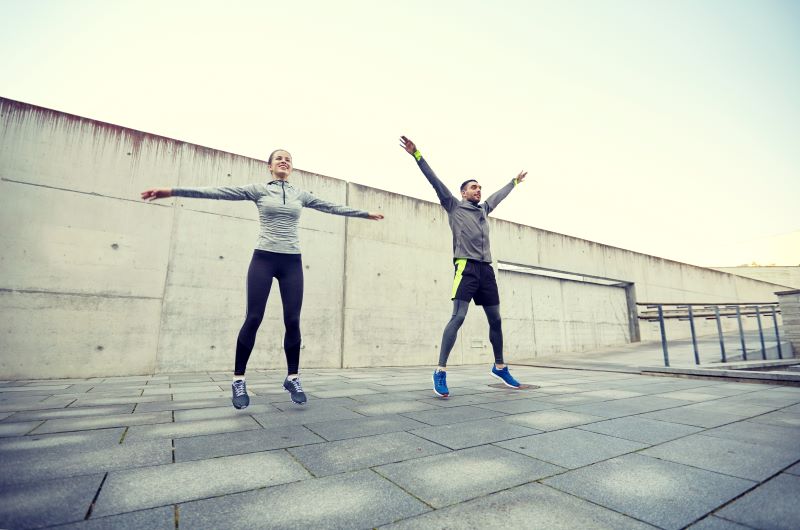
It is a cardio exercise which helps improve your heart rate while building muscle strength. It helps the heart to pump more blood across the body.
How to Do:
- For this exercise, stand on your, keeping them shoulder-width apart. Keep your arms alongside your body.
- Now, jump up and spread your feet as far as possible. Raise your overhead and clap your hands together.
- Next, jump back to the starting position. Continue at least 2-3 sets of 15-30 jumps.
Benefits:
This workout for muscular strength is beneficial for bone health. It helps to improve the overall bone and muscle strength. Moreover, it helps to lose weight while looking after heart health. It also helps to reduce tension and stress. This exercise helps to build muscle strength while developing cardiovascular benefits.
It is a simple exercise but might cause injury and pain in the lower part of the body. People with pain in these areas should avoid such exercises. The risks will increase if there is a lack of a base level of strength and conditioning.
15. Burpee with Push-up
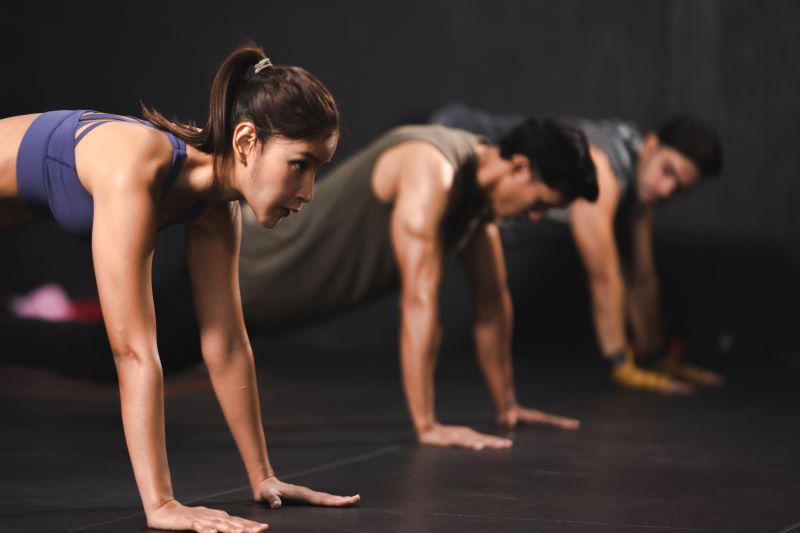
It is one of the most challenging yet effective exercises for muscular strength. It is a two-part exercise, including a pushup and a leap in the air. While doing several burpees can be tiring, it can be essential for building excellent muscle strength.
How to Do:
- Start this exercise by squatting with your knees bent, your back straight, and your feet about shoulder-width apart.
- Now, lower your hands to the floor while keeping your weight on your hands. Kick your feet back and come on your hands and toes in a pushup position.
- Next, do one pushup and then a frog kick by returning your feet to the starting position.
- Reach your arms over the head and jump quickly to return to the original position. After landing, get into a squat position. Keep repeating this.
Benefits:
This exercise has multiple benefits. It helps to burn calories while offering a full-body workout. Moreover, it boosts cardio fitness, which is good for your heart health. It also helps to burn fat. This exercise can help improve your overall physical fitness and convenience.
Burpees require good muscle strength on the upper body parts. If you need to improve, you should skip this part. Moreover, you should avoid this exercise if you face back or shoulder injuries.
16. Deadlifts
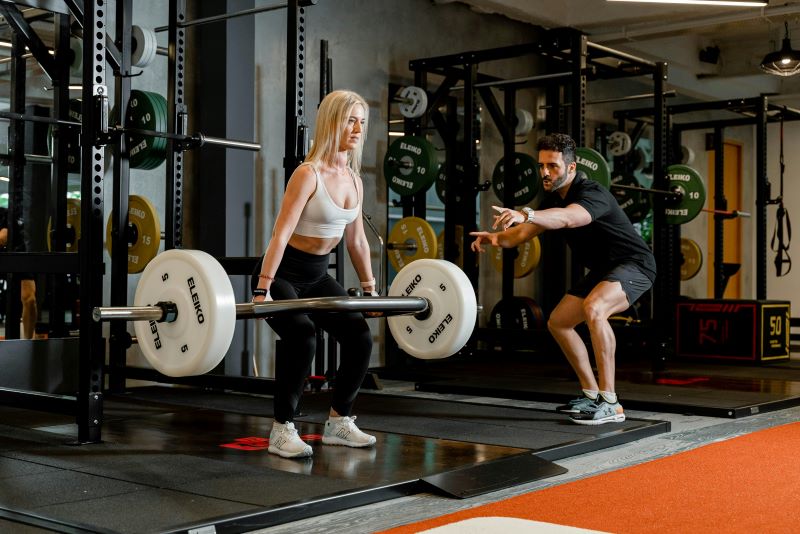
Deadlifts are compound exercises primarily targeting the lower back, glutes, hamstrings, and core muscles. In short, they challenge many muscles to work together, prompting them to grow stronger.
How to Do:
- Start with a barbell on the ground, feet hip-width apart, and toes pointing forward. Bend at your hips and knees to grip the barbell with your hands shoulder-width apart, palms facing you. Keep your back straight, chest up, and core engaged.
- Lift the barbell by driving through your heels and straightening your hips and knees simultaneously. Keep the barbell close to your body as you stand up straight.
- Pause at the top of the movement, then lower the barbell back to the ground by bending at your hips and knees while maintaining a flat back. Repeat for the desired number of repetitions.
Benefits:
Deadlifts strengthen the entire posterior chain, including the lower back, glutes, hamstrings, and calves. This exercise also engages the core muscles to stabilise the spine and maintain proper form. Deadlifts improve functional strength, making everyday activities like lifting and carrying heavy objects easier.
Avoid rounding your back or jerking the weight up, as this can increase the risk of injury.
17. Kettlebell Swings
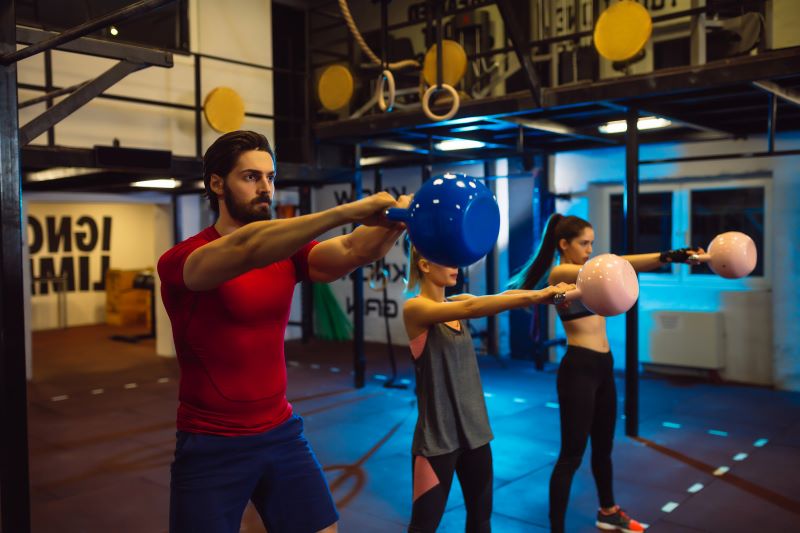
Kettlebell swings are dynamic full-body exercises targeting the posterior chain, including the glutes, hamstrings, and lower back.
How to Do:
- Stand with your feet shoulder-width apart, holding a kettlebell with both hands in front of you. Hinge at your hips and bend your knees slightly, keeping your back flat and chest up.
- Swing the kettlebell back between your legs, forcefully drive your hips forward and swing the kettlebell up to chest level.
- Keep your arms straight and engage your core throughout the movement. Control the kettlebell as it swings back between your legs, then immediately repeat the movement for the desired number of repetitions.
Benefits:
Kettlebell swings build explosive power in the hips and improve hip hinge mechanics. This exercise strengthens the glutes, hamstrings, and lower back, enhancing athletic performance and functional strength. Kettlebell swings also engage the core muscles to stabilise the spine and maintain proper alignment.
Use proper form and technique to avoid strain or injury, especially to the lower back and shoulders. Start with a lighter kettlebell and master the movement pattern before increasing the weight.
18. Medicine Ball Slams
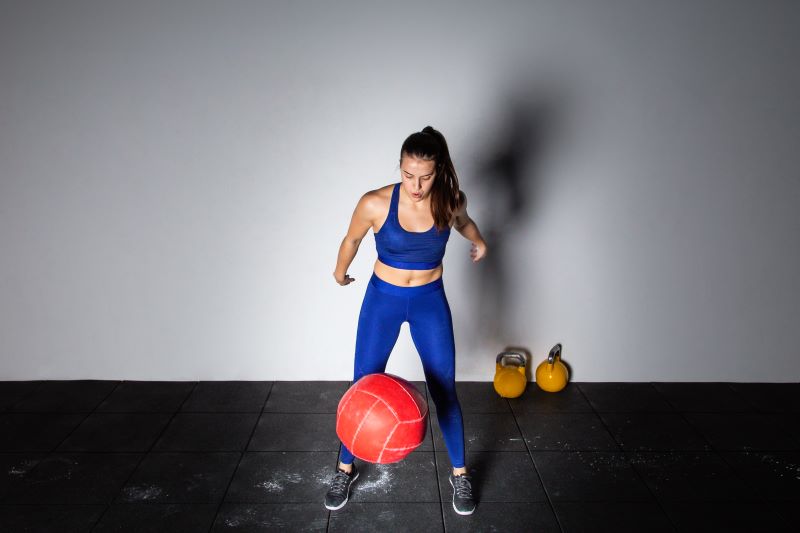
Medicine ball slams are dynamic full-body exercises that target the core, shoulders, and legs while providing a cardiovascular workout.
How to Do:
- Stand with your feet shoulder-width apart, holding a medicine ball with both hands in front of you.
- Lift the medicine ball overhead, fully extend your arms, and stand tall. Forcefully slam the medicine ball down to the ground before you, using your core, shoulders, and legs to generate power.
- Catch the medicine ball on the bounce and immediately repeat the movement for the desired number of repetitions.
Benefits:
Medicine ball slams improve power, explosiveness, and coordination, benefiting athletes and fitness enthusiasts. This exercise strengthens the core muscles, including the rectus abdominis, obliques, and transverse abdominis.
Medicine ball slams also engage the shoulders, arms, and legs, providing a full-body workout. They enhance cardiovascular fitness and calorie burn, making them a practical addition to HIIT workouts.
Types of Equipment Required for Muscular Strength Exercises
Certain muscular strength exercises require specific equipment to enhance their effectiveness and safety. This table lists exercises requiring equipment, ensuring a comprehensive workout routine.
Exercise |
Required Equipment |
| Biceps Curl | Dumbbells or Barbells |
| Gripping | Tennis Ball |
| Tricep Dips | Parallel Bars or Bench |
| Shoulder Press | Dumbbells or Barbell |
| Single-leg Hip Raise | Exercise Mat |
| Abdominal Crunch | Exercise Mat |
| Russian Twists | Medicine Ball or Dumbbell |
| Deadlifts | Barbell |
| Kettlebell Swings | Kettlebell |
| Medicine Ball Slams | Medicine Ball |
Benefits of Exercise for Muscular Strength
This muscular strength exercise list will benefit your health by improving your overall strength. In general, you can enjoy the following benefits.
- Overall strength: These exercises help build a strong body, allowing you to perform various movements and activities. It will supply power to the body without making it tired.
- Body weight: This exercise will also help you maintain a healthy weight. It will burn calories constantly while enhancing the body's composition, maintaining a ratio between fat and muscles.
- Mental health: A healthy body is essential for maintaining mental health. It boosts mood and energy levels if you feel down and depressed, and it also helps to boost confidence.
- Muscle and bone strength: Exercises for muscles naturally help in improving muscular strength. Moreover, it also increases bone strength. It helps improve your posture and relieve your back pain.
- Balance and stability: People start losing balance and stability with age. However, those who practice such exercises can improve their overall balance and stability. Their bones become flexible with increased grips. It reduces the chances of falling or injuries.
Who Should Avoid These Muscular Strength Exercises?
While beneficial for many, specific individuals should exercise caution or avoid these exercises altogether. Engage in these exercises with care, especially if you fall into one of the following categories:
- Existing Injuries or Pain: Individuals with pre-existing injuries or chronic pain should avoid exercises that exacerbate their condition.
- Joint Issues: Those with joint problems, such as arthritis or tendonitis, may find certain exercises too taxing on their joints.
- Cardiovascular Conditions: People with cardiovascular issues, like high blood pressure or heart disease, should avoid exercises that strain the heart.
- Pregnant Women: Pregnant women should steer clear of exercises that involve lying on their back or intense abdominal contractions.
- Uncontrolled Diabetes: Individuals with uncontrolled diabetes should avoid exercises that may cause sudden spikes or drops in blood sugar levels.
- Recent Surgeries: To avoid complications, people recovering from surgeries should consult their healthcare provider before engaging in strenuous exercises.
Things to Consider for Doing Muscular Strength Exercises Safely
You need to be careful if you are considering exercises for muscle strength. These can be dangerous and complex for people who are new to them. The following precautions can be helpful here.
- Proper technique: You must ensure proper technique while doing these exercises. For a proper routine, it is advisable to consult a registered fitness professional.
- Slow pace: It is advisable to start slowly since these exercises can be extremely challenging. If you are new to this, avoid going fast with the weights or intensity of the exercises. This will help you avoid any complications.
- Safe equipment: Consider safe equipment and tools for working out. Do not experiment since it can affect your health and safety. Professional gyms are the best options when you are starting.
- Posture and position: Learning about an exercise's position before working on it is essential. It can be dangerous to continue an exercise with the wrong posture.
- Overworking: You should always avoid overworking yourself. Every individual has their level of strength and capabilities. If you feel tired, you should avoid exercising and working out.
Therefore, as you can see, there are multiple exercises for muscular strength. These exercises can help build your muscle and bone strength. They will keep you physically fit for a long time. However, you should avoid intense workouts if you have pain or injuries in any body part.













